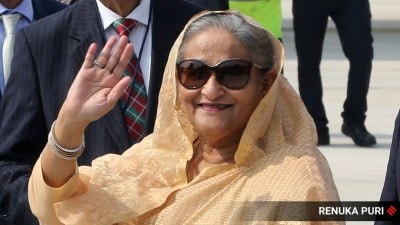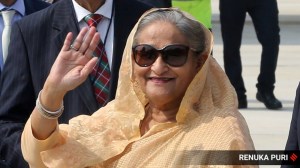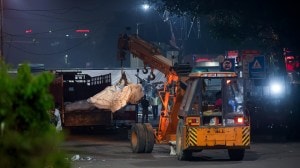But madam,This is too old to be new
The damnedest questions get thrown at artists seeking customs clearance for shows abroad.
The damnedest questions get thrown at artists seeking customs clearance for shows abroad.
Everyone has an airport story,an unhappy one usually: the time when the conveyor belt refused to rumble into action; when your bags were shipped to a city 1,000 km from your destination; or when one stale sandwich kept you company while waiting seven hours for your delayed flight.
But it was not the usual airport hiccups that Delhi-based artist Bharti Kher faced in March this year,when she had to send off artwork meant for her solo show at the Hauser and Wirth Gallery in London. She had the difficult task of convincing sceptical customs officials that one of her works,Confess,a traditional wooden marriage chamber from Kerala,covered with a profusion of bindis inside,was not an antique,but a contemporary Indian artists imaginative take on the idea of confession.
It was a week before my solo,and I had declared that Confess was worth over Rs 12 lakh. Customs officials immediately called it an antique and insisted that I get a certificate from the Archaeological Survey of India (ASI), says Kher. It took three days of negotiations with higher authorities,when the artist showed them a letter from the London gallery and earlier catalogues,to convince them that she was a contemporary artist,not someone who deals in antiques.
Droves of Indian artists are flying abroad to show their work to a growing and appreciative global audience; but they often trip up at the airport customs desk. There,an artist is on the same footing as,say,an exporter of pressure cookers. The trouble is that,unlike the ubiquitous pressure cooker,the formula to assess the value of the goods an artist trades in is not always manifestly clear. In May,for instance,Delhi gallery Nature Morte had a run-in with the customs while sending a set of six photographs by artist Gauri Gill to Art Basel in Switzerland. The photographs were priced at Gauris usual market price of Rs 60,000 each. The customs officials,however,were unable to understand how a new black-and-white photograph could be worth that much. They had evaluated it at Rs 500, says Peter Nagy of Nature Morte. When we insisted,they said it must be an antique and asked us to get it cleared by ASI, he says. If the work is undervalued at customs,it becomes difficult for artists to sell it outside.
Customs officials insist they are only doing their duty. The intellectual property rights of an artwork are difficult to ascertain. We need to check and be satisfied that the work is in fact worth the amount declared. Artists need to get that figure verified by a reliable source like the National Museum; sometimes a catalogue (stating the price) may be enough. It is our duty and we cannot take people at face value, says Muriel Michael,commissioner,exports air cargo,IGI airport,Delhi.
Khers troubles with Confess did not end at the valuation dispute. After being cleared by customs,it was knocked over by a fork lift and broken in a few places. I had to recall my work,remake it and resend it. It was just chaos at the customs office and trying to find a responsible person was impossible, she says. Commissioner Michael,though,insists that her officials are not to blame. The cargo is never handled by customs. We ask the customs house agent (usually the ground staff of the airlines) to open it,check it and reseal it, she says.
Gills black-and-white photographs need not have created a fuss,says joint commissioner of customs,central excise,Mumbai,
G Ravendranath,The reasons for revaluing these goods are not understood (sic). The export value becomes relevant only if the exporter claims any export incentive. There appears to be no incentive involved in this case. If the exporter was aggrieved by the actions of the customs officer,she/he should have instantly met the senior officers, he says.
Customs officials are not just staggered by the steep prices of artwork. They are also sensitive about any work with a whiff of obscenity. In 2008,Galerie Mrichandani+Steinruecke held a solo by German artist Jonathan Meese in Mumbai. One of his works,Dont Call Us,We Call You,was held up at the city airport. The sculpture depicted a man in uniform about to shoot a kneeling figure with an erection. None of the customs officials wanted to take responsibility for releasing it. Either they really thought it was obscene or they feared trouble from righteous elements, says Ranjana Steinruecke,co-owner of the gallery.
Although she took along an armful of books and catalogues on ancient and contemporary Indian art to the customs desk to show that Meese was not all that out of line,she was told that the work would have to be put up for judgment before a panel of six officials. At which point I decided it would be better to send the sculpture back to Germany, she says.



- 01
- 02
- 03
- 04
- 05




























